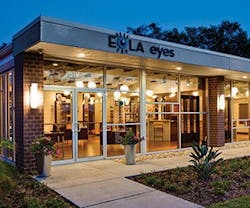Green for Less
The green movement has swept across our industry and has now entered the collective lexicon of the general public, as any designer or architect can attest. It seems that everyone these days wants to be “sustainable,” to “lower their carbon footprint,” and to build or renovate their homes and offices to be “healthy buildings.” And why wouldn’t they? We all have an innate desire to do the right thing. Being green satisfies our aspirations to help the environment and to create a better future for those who come after us.
In the United States, LEED has become the standard bearer for the design, construction and operation of green buildings. In fact, many jurisdictions at the federal, state and local levels are incorporating LEED guidelines into their building codes. Yet, despite the emerging trend, many companies have shied away from LEED certification as they make decisions with regards to the funding, construction and renovation of their facilities. The reasoning comes down to two ever-present realities: time and money.
challenges of
leed certification
While attaining LEED certification is considered by many to be the ultimate marker of sustainability, the reality is that it is not always easy, convenient or financially feasible. Chief amongst the barriers to certification that executives and business
owners publicly cite are the sizable corporate commitment and dedication of resources required. The most common reason that design professionals hear directly from clients is that LEED certification is simply too costly. Often times, this assertion rings quite true.
It has been reported that the upfront cost of LEED certification can increase total project costs by up to 10 percent. Sustainability proponents point to reduced life-cycle costs from energy savings and durability as a counterpoint, but this can be a difficult sell to a client whose capital expenditures budget is stretched as it is. There are alternatives to LEED certification, however, and many companies are more willing to commit to environmentally sustainable practices when design professionals can utilize the process of green integration.
Green integration is very similar to the design-build model, where the design team works in
tandem with the contractor to keep costs down and expedite the construction process. Similarly, green integration encourages innovation and
collaboration amongst architects, designers,
programmers, engineers and contractors for the collective purpose of achieving economically feasible sustainability solutions. While green integration may not directly result in the coveted LEED certification, it can provide many of the same life-cycle cost savings at a lower upfront cost. PageBreak
green integration in practice
Recently, my firm worked on the renovation of a late-1950s building in Orlando, Fla. The client, an optometry practice that had outgrown its previous location, applied for a Small Business Administration (SBA) loan to purchase and renovate the structure. The front of the west-facing building had floor-to-ceiling windows that were ideal for creating a
dramatic street-front presence and for providing ample natural light. But while their placement
was perfect for the function of the space, the fact that the virtually zero R-value windows directly faced the intense Florida sun presented a
significant economic challenge for the client.
It was obvious to the entire team that the inefficient windows would have to be replaced. In a traditional project mode, the architect would simply make a material specification for the new windows—failing to take full advantage of other cost-saving opportunities in the space. Because we proactively and collaboratively approached the project with the green integration process in mind, the team was able to provide a sustainable solution that produced both short- and long-term savings for the client.
To accomplish this, we first determined from a programming standpoint that the area near the windows would be used exclusively for retail and circulation space, thereby requiring lower cooling levels than other areas in the building. Because of the ample natural light entering through the windows, the lighting designer was able to reduce the number of fixtures in the space, reducing energy consumption along the way. It was determined that installing additional building insulation and highly efficient windows would allow for an HVAC system with a lower cooling load than would normally be required for a building in the area. Not only was the newly specified HVAC system less expensive, it also consumed less energy.
Collectively, these decisions not only reduced the upfront construction costs of the project, they also created an amortized cost savings for the client.
The key to the success of this project was early in-depth planning and intensive communication between all of the professionals throughout the green integration process.
So what can we derive from the example above? First and foremost, green integration can be a useful tool when applying for LEED certification. It can also be a great way to provide cost-effective sustainability solutions for the smaller business owner who lacks a LEED-sized budget. The design professional is the perfect coordinator for this collaborative mindset, as they are often the team member with the greatest awareness of the needs of the client. The process of green integration is a promising area where the experienced architect or designer can expand and differentiate their practice, all while helping push the mindset of sustainability forward.
Edward W. Woodill, III is the founder and design principal of Studio 3 Designs, a corporate design firm located in Orlando, Fla. He is also an alumnus of Rollins College and the Pratt Institute Graduate Interior Design program. Studio 3 Designs can be found online at http://studio3designs.com.
